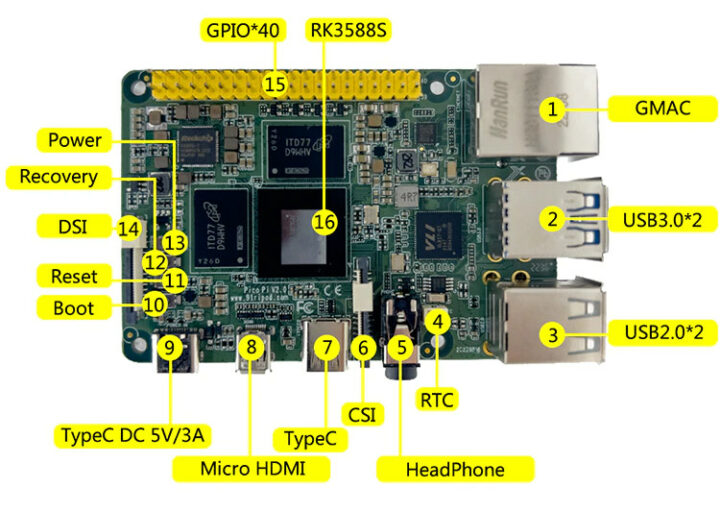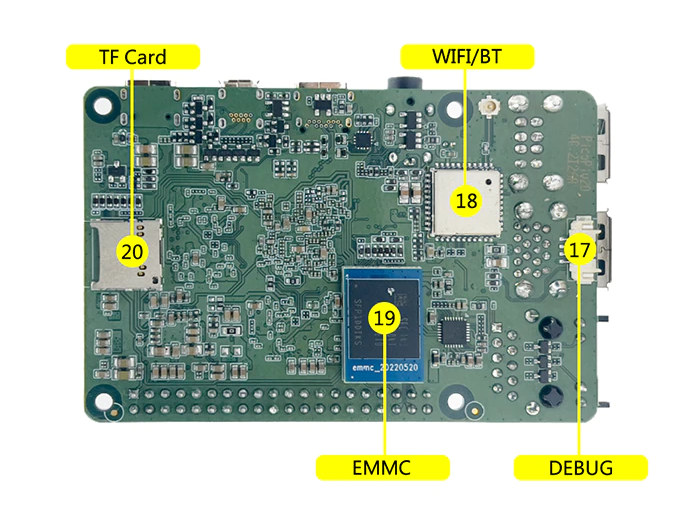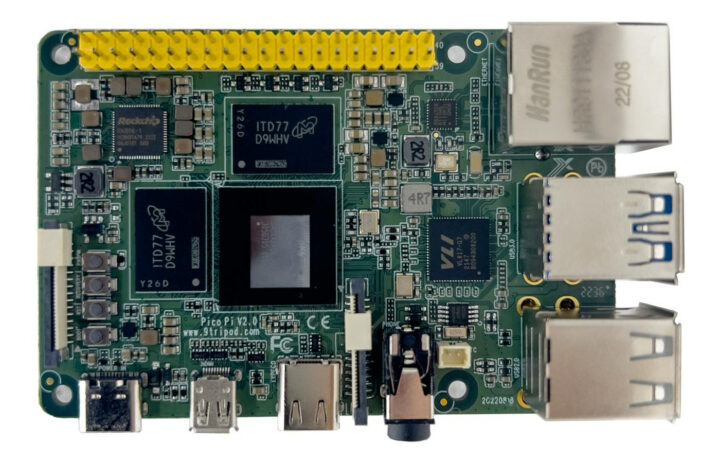9Tripod Pico Pi V2.0 is the third Rockchip RK3588S SBC offering a powerful alternative to Raspberry Pi 4 while keeping the same form factor. It follows the Cool Pi 4 and Radxa ROCK5 Model A single board computers introduced in the last couple of months.
The Pico Pi SBC, not to be confused with the Raspberry Pi Pico :), comes with 1GB to 32GB RAM, 4GB to 128GB eMMC flash, and pretty much the same port layout as the Raspberry Pi 4, except for one of the micro HDMI ports being replaced by a USB Type-C port with support for DisplayPort.
9Tripod Pico Pi V2.0 specifications:
- SoC – Rockchip RK3588S
- CPU – Octa-core processor with 4x Cortex-A76 cores @ up to 2.2-2.4 GHz, 4x Cortex-A55 cores @ up to 1.8 GHz
- GPU – Arm Mali-G610 GPU with OpenGL ES 3.2, OpenCL 2.2, and Vulkan 1.2 support
- VPU – 8Kp60 video decoder for H.265/AVS2/VP9/H.264/AV1 codecs, 8Kp30 H.265/H.264 video encoder
- AI accelerator – 6 TOPS NPU
- System Memory – 1GB, 2GB, 4GB, 8GB, 16GB, or 32GB LPDDR4x
- Storage – MicroSD card socket, optional eMMC 5.1 flash module connector to add 4GB, 8GB, 16GB, 32GB, 64GB, or 128GB module
- Video Output
- 1x micro HDMI 2.1 port
- DisplayPort via USB Type-C port (TBC)
- 4-lane MIPI DSI connector
- Camera I/F – MIPI CSI connector (4-lane or 2x 2-lane)
- Audio – 3.5mm earphone jack
- Networking
- Gigabit Ethernet RJ45
- Unnamed dual-band WiFi and Bluetooth 5.0 module
- USB – 2x USB 3.0 Type-A ports, 2x USB 2.0 Type-A ports, 1x USB Type-C port
- Expansion – 40-pin Raspberry Pi compatible GPIO header
- Debugging – 4-pin debug connector (probably for serial console)
- Misc
- Power, Recovery, Reset, and Boot buttons
- Power LED, user LED
- RTC battery connector
- Power Supply – 5V/3A via USB Type-C port
- Dimensions – 85 x 56mm (Raspberry Pi 4 form factor)

 The Pico Pi V2.0 supports Android 12 and Debian 11 operating systems as well as the Yocto Project to build custom Linux distributions. I won’t talk about performance too much since we’ve covered it in other writings, but basically, this SBC will deliver the processing performance of roughly 3 to 4 Raspberry Pi 4 boards depending on the workload, and it also includes a 6 TOPS NPU for AI tasks.
The Pico Pi V2.0 supports Android 12 and Debian 11 operating systems as well as the Yocto Project to build custom Linux distributions. I won’t talk about performance too much since we’ve covered it in other writings, but basically, this SBC will deliver the processing performance of roughly 3 to 4 Raspberry Pi 4 boards depending on the workload, and it also includes a 6 TOPS NPU for AI tasks.
The product page calls it the Pico PC RK3588S instead of the Pico Pi V2.0 on the silkscreen, and comes with some very basic documentation in Chinese, but nothing about software that I could find. We’ve written about 9Tripod products before, and they seem to mostly cater to the mainland China market. I don’t see any major features that would warrant buying the Pico Pi V2.0/Pico PC RK3588S over the Cool Pi 4 or ROCK5 Model A which have documentation in English and images to download.
But if you feel adventurous, the 9Tripod Pico Pi V2.0 SBC is available for sale on Aliexpress for $124.10 to $168.88 depending on the memory and flash module configuration up to 8GB RAM and 32GB flash. The 16GB RAM models are out of stock, and 32GB RAM seems like a pipe dream since nobody has ever sold a Rockchip RK3588(s) with that amount of RAM.

Jean-Luc started CNX Software in 2010 as a part-time endeavor, before quitting his job as a software engineering manager, and starting to write daily news, and reviews full time later in 2011.
Support CNX Software! Donate via cryptocurrencies, become a Patron on Patreon, or purchase goods on Amazon or Aliexpress






The orange Pi 5 is also available with 32GB of ram. but it’s a silly amount for this kind of board in my opinion. https://www.cnx-software.com/2022/11/11/orange-pi-5-most-affordable-rockchip-rk3588s-sbc/
I can only find it with up to 16GB RAM on Aliexpress. Several companies have announced their board can support up to 32GB RAM, but none have sold it with this capacity.
Probably because the demand of such amount of RAM is too low to make it an retail option. For such niche use case a BTO option is more reasonable.
For 32GB RAM with RK3588(s) you need two LPDDR4 modules with 16GB (128Gb) each while AFAIK such packages are still not available and the same applies for 96Gb as well.
Meanwhile, Qualcomm, Apple and Samsung have all been in the process of moving to the newer LPDDR5(x).
One wonders if there will ever be a critical mass of demand to produce larger modules of, already superseded, LPDDR4 for the Rockchip SBC niche…
https://www.micron.com/products/dram/lpdram/part-catalog -> there sort by Density. I must have overlooked that yesterday but Micron shows four 128Gb LPDDR4 modules as ‘Production’.
Though no idea whether those can be combined with RK3588(s) or not.
Orange Pi told me it’s because of the cost a few months ago.
Hi Jean Which is the best compatible dac board for orange pi.
I was going to post exactly that, both the Orange Pi 5 and 5 Plus have been selling with 32GB RAM for a while (even if the 32GB model is out-of-stock right now).
As per 32GB being ridiculous, I disagree: I have a use case where 32GB comes in handy.
It’s a real shame software support sucks for these little monsters.
Can it possible to use it as a streamer. If so which is the best compatible dac board. How much its price.
The only thing that got my attention was the usbc DP port…
But I’m not even sure that’s the case. I assumed that because USB 3.0 and DP are multiplexed in RK3588 and I had seen it used that way in another board (can’t remember which one).
Well however it is, it’s a shame rpi4 has those flimsi micro hdmi, that’s why mine is collecting dust as if it was an allwinner tv box 😛
DP alt mode on hdmi works perfectly on laptops, sad not on those boards
Sell it while it’s valuable
It doesn’t seem there is any USB C controller, so maybe as you stated it could be changed in the DT to native DP but this would most likely require some sort of a passive adapter…
I really hope the pi form factor goes away in favour of one that has all the ports on one edge or on header pins
This board is available for preorder at ameridroid as ‘indiedroid nova.’
At $145 for the 4GB model I can’t see it selling well.
Let’s compare it to Khadas Edge2
9Tripod /// Khadas
LPDDR4X /// LPDDR4
uSD /// none
128Gb eMMC /// 64Gb eMMC (max)
neither has an M.2 slot
2 USB 2.0 /// 1 USB 2.0
USB-C already mentioned
Audio 3.5 mm /// microphone
Khadas has the well reviewed OOWOW firmware for loading an OS.
both have same CPU, NPU, GPU, etc
both max out at 16 Gb memory
both have 2 USB 3.0
both have Video Decode 8K@60, Encode 8K@30
both have 1 HDMI
both have Ethernet, WiFi and Bluetooth 5.0
both have MIPI-DSI, MIPI-CSI, 9Tripod has more channels
OS should be the same. Bo at Ameridroid tells me Ubuntu and Debian will
be available as well as the advertised JELOS and I would think Android.
I did a similar comparison with Pine, Radxa, Mekotronic and Orange Pi and the two above seem much better equipped to me. NanoPi is intended for routers. I could have gotten some figures wrong or ignored someone’s favorite spec. For instance, Edge2 has a 32 bit path to memory (I couldn’t find it for 9Tripod) but Pine, Radxa and Orange Pi have 64 bit.
Price is certainly competitive at $144.95 for barebones.
The 9Tripod Pico Pi v2.0 SBC is now known as the Indiedroid Nova in the rest of the world (i.e outside of mainland China):
https://www.cnx-software.com/2023/04/16/indiedroid-nova-rockchip-rk3588s-sbc-with-heatsink-fan-and-swappable-emmc-flash/